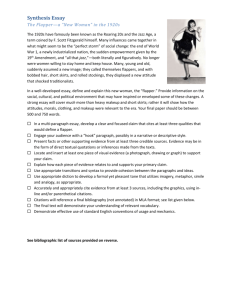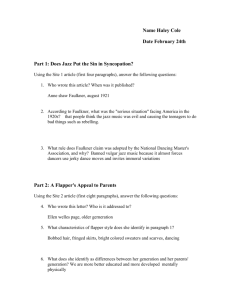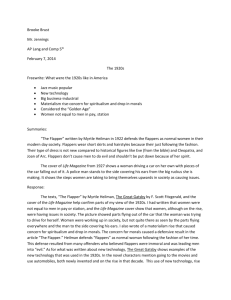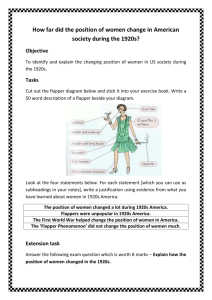Roaring 20s CLX - Women(Flappers)
advertisement
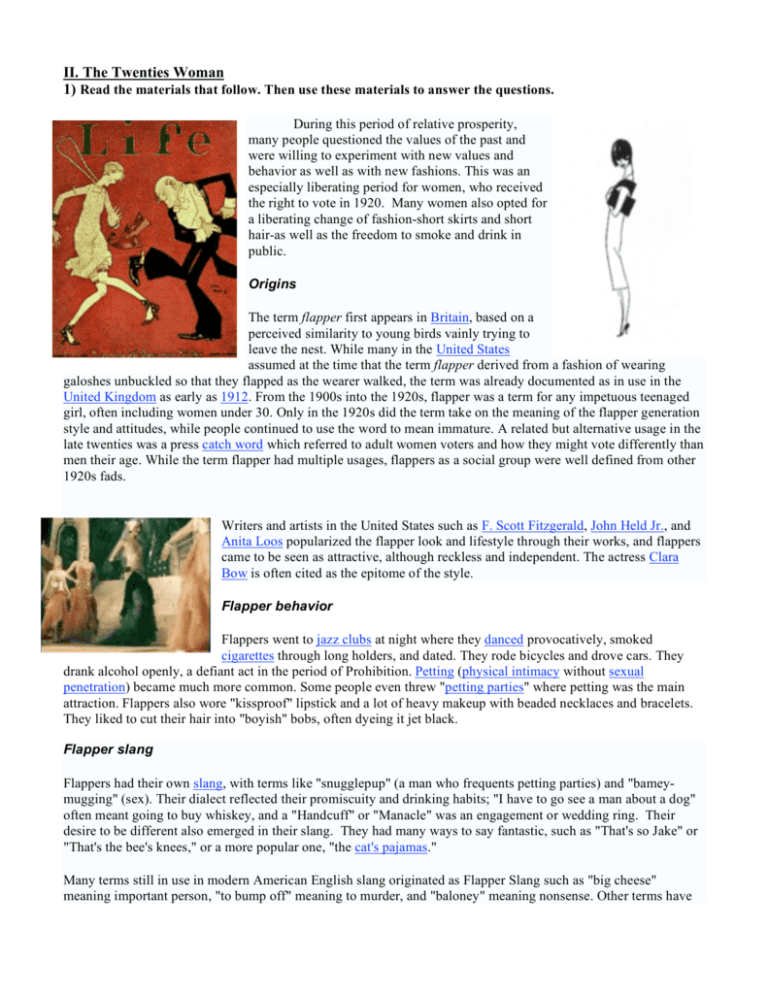
II. The Twenties Woman 1) Read the materials that follow. Then use these materials to answer the questions. During this period of relative prosperity, many people questioned the values of the past and were willing to experiment with new values and behavior as well as with new fashions. This was an especially liberating period for women, who received the right to vote in 1920. Many women also opted for a liberating change of fashion-short skirts and short hair-as well as the freedom to smoke and drink in public. Origins The term flapper first appears in Britain, based on a perceived similarity to young birds vainly trying to leave the nest. While many in the United States assumed at the time that the term flapper derived from a fashion of wearing galoshes unbuckled so that they flapped as the wearer walked, the term was already documented as in use in the United Kingdom as early as 1912. From the 1900s into the 1920s, flapper was a term for any impetuous teenaged girl, often including women under 30. Only in the 1920s did the term take on the meaning of the flapper generation style and attitudes, while people continued to use the word to mean immature. A related but alternative usage in the late twenties was a press catch word which referred to adult women voters and how they might vote differently than men their age. While the term flapper had multiple usages, flappers as a social group were well defined from other 1920s fads. Writers and artists in the United States such as F. Scott Fitzgerald, John Held Jr., and Anita Loos popularized the flapper look and lifestyle through their works, and flappers came to be seen as attractive, although reckless and independent. The actress Clara Bow is often cited as the epitome of the style. Flapper behavior Flappers went to jazz clubs at night where they danced provocatively, smoked cigarettes through long holders, and dated. They rode bicycles and drove cars. They drank alcohol openly, a defiant act in the period of Prohibition. Petting (physical intimacy without sexual penetration) became much more common. Some people even threw "petting parties" where petting was the main attraction. Flappers also wore "kissproof" lipstick and a lot of heavy makeup with beaded necklaces and bracelets. They liked to cut their hair into "boyish" bobs, often dyeing it jet black. Flapper slang Flappers had their own slang, with terms like "snugglepup" (a man who frequents petting parties) and "bameymugging" (sex). Their dialect reflected their promiscuity and drinking habits; "I have to go see a man about a dog" often meant going to buy whiskey, and a "Handcuff" or "Manacle" was an engagement or wedding ring. Their desire to be different also emerged in their slang. They had many ways to say fantastic, such as "That's so Jake" or "That's the bee's knees," or a more popular one, "the cat's pajamas." Many terms still in use in modern American English slang originated as Flapper Slang such as "big cheese" meaning important person, "to bump off" meaning to murder, and "baloney" meaning nonsense. Other terms have become definitive of the prohibition era such as "speakeasy" meaning an illegal place to get liquor and "hooch” describing illegal liquor. Flapper dress In addition to their outrageous behavior, flappers were known for their style, which largely emerged as a result of the musical style of jazz and the popularization of dancing that accompanied it. Called garçonne in French ("boy" with a feminine suffix), flapper style made them look young and boyish. The short "bob" haircut became popular, only to be replaced later by the shorter "Eton" or "shingle" which slicked the hair and covered the ears with curls. Flappers did away with their corsets and pantaloons in favor of "step-in" panties. Without corsets, flappers wore simple bust bodices to make their chest hold still when dancing. Without the added curves of a corset they promoted their boyish look, and soon early popular bras were sold to flatten and reduce the appearance of the bust. Flapper-style outfits Flapper dresses were straight and loose, leaving the arms bare and dropping the waistline to the hips. Rayon stockings were attached to garter belts. Skirts rose to just below the knee by 1927, allowing flashes of knee to be seen when a flapper danced or walked through a breeze, although the way they danced made any long loose skirt flap up to show their knees. Flappers powdered or put rouge on their knees to show them off when dancing. A round hat called a cloche usually finished the look. Perhaps most scandalously, flappers also took to wearing make-up, previously restricted to actresses and prostitutes. Popular flapper make-up styles made the skin pale, the lips red, and the eyes black-ringed. All of this encouraged the development of shocking dance styles such as the Charleston, the Shimmy, the Bunny Hug and the Black Bottom. Despite all the scandal flappers generated, their look became fashionable in a toned-down form among even respectable older women. Most significantly, the flappers removed the corset from female fashion and popularized short hair for women. Among the actresses most closely identified with the style were THE FLAPPER by Dorothy Dorothy Mackaill, Alice White, Bebe Daniels, Billie Dove, Helen Parker Kane, Joan Crawford, Leatrice Joy, Norma Shearer, Laura La Plante, Norma Talmadge, Clara Bow, Louise Brooks, and Colleen Moore. The Playful flapper here we see, The fairest of the fair. She's not what Grandma used to be, -You might say, au contraire. Her girlish ways may make a stir, Her manners cause a scene, But there is no more harm in her Than in a submarine. She nightly knocks for many a goal The usual dancing men. Her speed is great, but her control Is something else again. All spotlights focus on her pranks. All tongues her prowess herald. For which she well may render thanks To God and Scott Fitzgerald. Her golden rule is plain enough Just get them young and treat them rough. End of the flapper era Despite its popularity, the flapper lifestyle and look could not survive the Great Depression. The high-spirited attitude and hedonism simply could not find a place amid the economic hardships of the 1930s which brought out a conservative reaction and a religious revival that set out to eradicate the liberalism of the 1920s. In many ways, however, the self-reliant flapper had allowed the modern woman to make herself an integral and lasting part of the Western World. A FLAPPER'S APPEAL TO PARENTS by Ellen Welles Page The following excerpts were taken from an article by Ellen Welles Page, which appeared in Outlook magazine on December 6, 1922. If one judge by appearances, I suppose I am a flapper. I am within the age limit. I wear bobbed hair, the badge of flapperhood. (And, oh, what a comfort it is!), I powder my nose. I wear fringed skirts and bright-colored sweaters, and scarfs, and waists with Peter Pan collars, and low- heeled "finale hopper" shoes. I adore to dance. I spend a large amount of time in automobiles. I attend hops, and proms, and ball-games, and crew races, and other affairs at men's colleges. But none the less some of the most thoroughbred superflappers might blush to claim sistership or even remote relationship with such as I. I don't use rouge, or lipstick, or pluck my eyebrows. I don't smoke (I've tried it, and don't like it), or drink, or tell "peppy stories." I don't pet. And, most unpardonable infringement of all the rules and regulations of Flapperdom, I haven't a line! But then--there are many degrees of flapper. There is the semi-flapper; the flapper; the superflapper. Each of these three main general divisions has its degrees of variation. I might possibly be placed somewhere in the middle of the first class. I want to beg all you parents, and grandparents, and friends, and teachers, and preachers--you who constitute the "older generation"--to overlook our shortcomings, at least for the present, and to appreciate our virtues. I wonder if it ever occurred to any of you that it required brains to become and remain a successful flapper? Indeed it does! It requires an enormous amount of cleverness and energy to keep going at the proper pace. It requires self- knowledge and self-analysis. We must know our capabilities and limitations. We must be constantly on the alert. Attainment of flapperhood is a big and serious undertaking! New Roles of Women At Home and at Work: The fast-changing world of the 1920’s produced new roles for women in the workplace and new trends in family life. Although women had worked successfully during the war, afterwards employers who believed that men had the responsibility to support their families financially often replaced female workers with men. Thought women continued to seek paid employment, their opportunities changed to “women’s professions” and became teachers, nurses, and librarians. Big business created a huge demand for clerical workers such as typists, filing clerks, secretaries, stenographers, and office-machine operators. A handful of women broke the old stereotypes by doing work once reserved for men, such as flying airplanes, driving taxis, and drilling oil wells. Changing Family: Widespread social and economic changes reshaped the family. The birthrate had been declining for several decades, and it dropped at a slightly faster rate in the 1920s. This decline was due in part to the wider availability of birth-control information. Margaret Sanger, who had opened the first birth-control clinic in the United States in 1916, founded the American Birth Control League in 1921 and fought for the legal rights of physicians to give birth-control information to their patients. At the same time, social and technological innovations simplified household labor and family life. Stores overflowed with ready-made clothes, sliced bread, and canned foods. These innovations and institutions had the effect of freeing homemakers from sort of their traditional family responsibilities. As their spheres of activity and influence expanded, women experienced greater equality in marriage. Marriages were based increasingly on romantic love and companionship.
